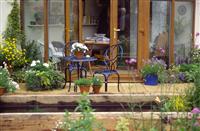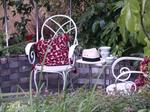Gardening On Verandahs and Balconies

It’s amazing how a small space can be transformed into a stunning feature. With a little imagination, a verandah or balcony can become a striking feature of your home, drawing your attention from the interior of the house, and creating a feel of extra space.
Balconies
A balcony is an outside area attached to an inside room of a house, apartment, flat or other building. It is usually only accessible from inside the building. Balconies are usually built in multi-story buildings, to provide a small outdoor living area for units or apartments which are above ground level.
Verandahs
Like balconies, verandahs are outside areas attached to a building, however they differ from balconies in that they generally have access not only from within the building, but also from the outside. Verandahs are also commonly roofed, either partly or fully.
Balconies and verandahs are a transition zone linking the outdoors with the interior of a building. Balconies and verandahs can come in all sizes, from tiny apartment verandahs of only a couple of square metres to areas the size of a large room. Landscaping a balcony or verandah is like landscaping any other type of garden…planning is the key.
LANDSCAPING A BALCONY OR VERANDAH
Some things to consider:
What are some possible uses for the balcony or verandah.
Your selection will depend on the amount of space available and its outlook. You might decide to use the area for sunbaking, outdoor entertaining, eating outside, for growing cut flowers, to use as a kitchen garden, or mostly for aesthetics (to make the building look good from outside, or to provide a feature to look at from inside).
The wall of the building backing the balcony or verandah.
Consider the style or look of the wall. If it's attractive, then landscape to complement it and show it off. If it's unattractive, then landscape to hide the wall, or perhaps decorate the wall by painting to improve the appearance of the wall. If the wall is mainly glass, do you want to restrict the amount of light passing through, or create some privacy? Do you want to maintain as much light entering the building as possible? These considerations will have a big impact on placement of plants or features such as seating.
Are there side walls?
These will help to further contain the balcony or verandah. This can have a variety of effects, such as blocking off neighbouring units, restricting good views or blocking out bad ones, reducing the overall feeling of space that open verandahs provide, or reducing wind (which can be beneficial in that it makes the area more pleasant, or conversely it can reduce the cooling effect that the wind provides on hot days).
Is the balcony or verandah roofed?
This can have a major effect on what type of plants you grow, and how they are grown. Roofs will provide protection against harsh weather such as frost or strong winds, but they will also restrict the amount of natural rainfall reaching the plants, requiring you to undertake more regular watering. Roofs may also restrict the amount of light reaching rooms adjacent to the balcony or verandah, and reduce the light available to plants. Consider carefully the type of roofing material you use. Clear roofing materials such as polycarbonate can allow good light penetration, provide protection against UV light, and yet still provide protection against the elements.
What type of balustrade, rails or fence surrounds the balcony or verandah?
If it's unattractive then hide it with plants in pots. If you have children, however, you may choose to avoid placing objects such as garden furniture or plant containers too close to the fences or balustrade, as they may represent too great a temptation for the children to climb. On verandahs that are low to the ground and don’t require a protective barrier, then plants planted below the verandah can be used to provide some level of privacy, and as a means of indicating where people should enter on and off the verandah.
What type of windows or doors lead or look out onto the balcony or verandah?
Remember the view from inside. It is important to avoid placing objects, such as outdoor furniture, B-B-Q's, or plant containers where they will create obstructions or reduce access. A good way to check this out is to sit down in various locations and look out through any doors or windows that adjoin balconies or verandahs. You might try temporarily placing some containers of plants, or outdoor furniture in various positions around the balcony or verandah to see what effects are created. You will be able to observe which views are blocked, where private areas are created, and so on. Be careful to allow access to windows for cleaning.
Surfaces might be dressed up by paving, or by painting to create different effects.
This includes both the floor and walls, for example a beach or garden scene might be painted on a wall to create a theme which is extended onto the balcony or veranda in the types of plants, furniture or ornaments used.

Getting more use of available space.
This can be achieved by using window boxes hanging on the outside of the balustrade, attaching hanging baskets from the eaves, or attaching hanging baskets from a pergola above the balcony.
If space allows, you can consider a BBQ, outdoor furniture, feeders or baths to attract birds, or even small statuary. Bird feeders might also be hung from trees adjacent to the balcony or verandah to attract birds in close for your viewing. Lights might also be hung from adjacent trees, or small spotlights attached to the building to highlight night time scenes.
THE ENVIRONMENT OF BALCONIES & VERANDAHS
Balconies and verandahs are often exposed places which can be inhospitable to many types of plants. Wind in particular may be a problem, and depending on the aspect, a balcony or verandah may be either a sun trap, becoming too hot at times; or continually in the shade, starved of light and warmth particularly in winter. Balconies and verandahs may be protected by large trees growing nearby, or shaded by adjacent tall buildings. Large structures may also create wind tunnels though, complicating the task of successful gardening. Rooves over balconies or verandahs can provide protection, particularly against frost, but more regular watering is then required.
There are plenty of hardy plants, however, which will grow well in even the harshest conditions.
HOW TO GROW PLANTS ON BALCONIES OR VERANDAS

Drying out
Plants are normally grown in some type of container on a balcony. If the area is exposed to wind, or excessive heat, it is important to avoid the roots drying out. There are a few things you can do to minimise this:
- Grow in larger containers (e.g. big pots or large planter boxes with a deep soil of at least 50cm depth).
- Provide a constant supply of water by using a capillary watering system, a drip irrigation system, or a hydroponic system. Watering of your plants will be much easier if there is access on the balcony or verandah to a tap, or a water pipe that can be accessed in some way.
- Mulch plants heavily.
- Use drought resistant plants.
- Build a wind break (e.g. erect a wall of shade cloth across one end of the balcony or verandah).
- Use a good quality potting soil. Soils which conform to Australian soil standards will usually have fewer problems with drying out. These are sometimes more expensive than their potting mixes, but generally well worth the extra expense.
- Add things to your potting mixes to improve their ability to hold moisture (e.g. peat moss, or water storing granules & wetting agents.
Nutrition
Regular feeding is important! Nutrients will be lost from the growing media, both through leaching away in drainage water and through plants extracting nutrients from soil. Frequent light applications of nutrients are preferable. Heat and frequent watering can cause a greater leaching of fertiliser through the bottom of pots than might otherwise be the case. Recent research has shown it is not uncommon for up to 90% of fertiliser applied to container grown plants by some nurserymen to be wasted! Slow release fertilisers are best in most cases. Cover the fertiliser with mulch or potting mix, so that direct heating from the sun doesn't cause chemicals to be released too fast. Be careful not to over fertilise (follow manufacturers recommendations) otherwise your plants may suffer from salinity problems, or they may grow to vigorously requiring more maintenance.
Limited Growing Space
Careful plant selection will ensure you choose plants that are not to vigorous for the amount of space you have available. Alternatively you might need to spend a lot of time either pruning, or regularly replacing plants as they get too big (some gardeners like to do this to create a dynamic garden). You can also choose some form of intensive gardening, including bonsai, hydroponics, and topiary. Bonsai, in particular, can create the impact of a much larger garden.
Using Containers
Growing your plants in containers allows you to readily change your garden as you desire, moving plants around to create new vistas. Don't limit yourself in the types of containers you use. Plants have been successfully grown on balconies or verandahs in such things as wheeled plastic rubbish collection bins, in appropriately painted galvanised rubbish bins, in old wooden or polystyrene fruit boxes, and in plastic hobby boxes.
PLANTS FOR BALCONIES & VERANDAHS
With the right attention, you can grow most things on a verandah. Select plants to suit the space available. Large plants that require frequent pruning may be inappropriate. What will you do with the prunings? If you plan on spending a lot of time gardening in a small area, you might consider vegetables, herbs, miniature fruit trees, cut flowers, and pots of bulbs. If time is limited though, you might be better to consider hardier plants. Some plants can have a high maintenance requirement if kept on a balcony or verandah. In particular avoid the use of plants that have a tendency to drop leaves, twigs, or fleshy fruits and berries. Decomposing plant parts can be slippery, and are a chore to pick up on a regular basis. Rampant growers should also be avoided as they soon take over what space you have, often choking out other plants.
LIST OF BALCONY and VERANDAH PLANTS FOR NORTHERN AUSTRALIA
HARDY & LOW MAINTENANCE:
| Cacti |
Bromeliads |
| Kalanchoe |
Alternanthera |
| Asparagus fern |
Nephrolepis (Fishbone Fern) |
| Ivy (when kept contained) |
Mondo grass |
| Zygocactus |
COLOURFUL AND RELATIVELY HARDY:
| Orchids (some shade may be needed) |
Poinsettia |
| Bougainvillea |
Nerium oleander |
| Bulbs/Flowers: Zephranthes, Hippeastrum, Day lily, Portulaca, Marigold |
LIST OF BALCONY & VERANDAH PLANTS FOR SOUTHERN AUSTRALIA
HARDY & LOW MAINTENANCE:
| Cacti & Succulents |
Asparagus fern |
| Nephrolepis (Fishbone Fern) |
Tradescantia (Wandering Jew) |
| Geraniums & Pelargoniums |
Daisies |
| Cymbidium orchids |
Bromeliads |
| Bamboo |
Conifers |
| Roses |
Citrus |
COLURFUL AND RELATIVELY HARDY:
| Azaleas |
Nerium oleander |
| Lavender |
Pelargoniums |
| Daisies |
| Bulbs/Flowers: Agapanthus, Freesia, Grape Hyacinth, Scilla, Marigold, Begonia |
| Phormium -coloured leaf varieties(New Zealand Flax) |
Want to Know More?
Consider doing a course or buying a reference book from our school.
If you would like to communicate with one of our professional tutors, consider using our free course counselling service. click for details
If you want to browse our bookshop, go to www.acsbookshop.com
To browse our courses, go to http://www.acsgarden.com/Courses/Default.aspx
More from ACS
Ebook - Inspiring: covers formal, natural, eclectic, modern, oriental, Mediterranean; zoom in on stunning images and plans.
View eBook
Ebook - a great informative text to extend your knowledge and get it right the first time!
View eBook